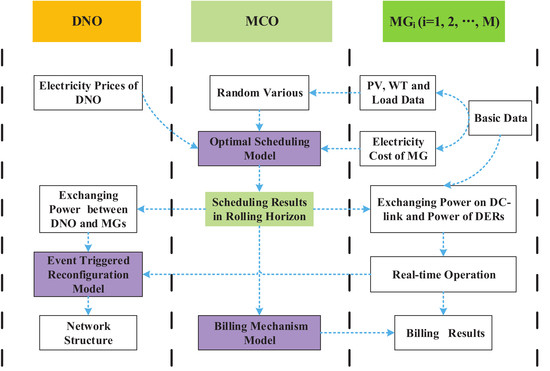Multi-Party Optimal Operation for Distribution Networks Containing DC-Linked Microgrids: Integrated Network Reconfigurations and Energy Sharing
Abstract
:1. Introduction
- (1)
- A multi-party optimization framework is designed, which includes the reconfiguration of the distribution network and scheduling of the DC-linked MGs.
- (2)
- For the DC-linked MGs, a stochastic optimal scheduling model for the coalition is formulated, considering the uncertainties of PV, WT, and load power. Moreover, a billing mechanism is designed to distribute the cost the coalitional operations.
- (3)
- For the distribution network, an event triggered dynamic reconfiguration model is proposed. The decisions of switch operations are finally co-decided by the expected exchanging power of the MGs and the real-time errors caused by uncertainty factors.
2. Framework
3. Stochastic Scheduling Model of DC-Linked MGs
3.1. Basic Model
3.1.1. Load
3.1.2. RES
3.1.3. Synchronous Generator
3.2. Objective Function
3.3. Constraints
3.3.1. Power Balance
3.3.2. Power Constraints of Generators
3.3.3. Exchanging Power Constraints
3.3.4. Constraints
3.4. Solution
4. Dynamic Reconfiguration of Distribution Network
4.1. Power Loss Model
4.2. Power Loss Model Considering the DC-Linked MGs
4.3. Event Triggered Dynamic Reconfiguration Model
4.4. Constraints
4.4.1. Voltage Constraints
4.4.2. Branch Power Limit
4.4.3. Network Structure Constraints
4.5. Solution Algorithm
5. Billing Mechanism
6. Case Study
6.1. Results of Stochastic Scheduling
6.2. Results of Billing Mechanism
6.3. Results of Event Triggered Dynamic Reconfiguration
7. Conclusions
Acknowledgments
Author Contributions
Conflicts of Interest
References
- Capitanescu, F.; Ochoa, L.F.; Margossian, H.; Hatziargyriou, N.D. Assessing the Potential of Network Reconfiguration to Improve Distributed Generation Hosting Capacity in Active Distribution Systems. IEEE Trans. Power Syst. 2015, 30, 346–356. [Google Scholar] [CrossRef]
- Liu, N.; Tang, Q.; Zhang, J.; Fan, W.; Liu, J. A hybrid forecasting model with parameter optimization for short-term load forecasting of micro-grids. Appl. Energy 2014, 129, 336–345. [Google Scholar]
- Cingoz, F.; Elrayyah, A.; Sozer, Y. Optimized Settings of Droop Parameters Using Stochastic Load Modeling for Effective DC Microgrids Operation. IEEE Trans. Ind. Appl. 2017, 53, 1358–1371. [Google Scholar] [CrossRef]
- Che, L.; Zhang, X.; Shahidehpour, M.; Alabdulwahab, A.; Abusorrah, A. Optimal Interconnection Planning of Community Microgrids With Renewable Energy Sources. IEEE Trans. Smart Grid 2015, 8, 1054–1063. [Google Scholar] [CrossRef]
- Liu, N.; Yu, X.; Wang, C.; Li, C.; Ma, L.; Lei, J. Energy-Sharing Model With Price-Based Demand Response for Microgrids of Peer-to-Peer Prosumers. IEEE Trans. Power Syst. 2017, 32, 3569–3583. [Google Scholar]
- Liu, N.; Yu, X.; Wang, C.; Wang, J. Energy Sharing Management for Microgrids With PV Prosumers: A Stackelberg Game Approach. IEEE Trans. Ind. Inform. 2017, 13, 1088–1098. [Google Scholar] [CrossRef]
- Nutkani, I.U.; Loh, P.C.; Blaabjerg, F. Distributed Operation of Interlinked AC Microgrids with Dynamic Active and Reactive Power Tuning. IEEE Trans. Ind. Appl. 2013, 49, 2188–2196. [Google Scholar]
- Koyanagi, K.; Hida, Y.; Yokoyama, R.; Nagata, S.; Nakao, K.; Hirai, T. Electricity Cluster-Oriented Network: A grid-Independent And Autonomous Aggregation of Micro-Grids. In Proceedings of the International Symposium on Modern Electric Power Systems, Wrocaw, Poland, 20–22 September 2010; pp. 1–6. [Google Scholar]
- Chaudhary, S.K.; Guerrero, J.M.; Teodorescu, R. Enhancing the Capacity of the AC Distribution System Using DC Interlinks: A Step Toward Future DC Grid. IEEE Trans. Smart Grid 2015, 6, 1722–1729. [Google Scholar]
- Romero-Ramos, E.; Gomez-Exposito, A.; Marano-Marcolini, A.; Maza-Ortega, J.M.; Martinez-Ramos, J.L. Assessing the loadability of active distribution networks in the presence of DC controllable links. IET Gener. Transm. Distrib. 2011, 5, 1105–1113. [Google Scholar] [CrossRef]
- Cao, W.; Wu, J.; Jenkins, N.; Wang, C.; Green, T. Operating principle of Soft Open Points for electrical distribution network operation. Appl. Energy 2016, 164, 245–257. [Google Scholar] [CrossRef]
- Zhao, B.; Shi, Y.; Dong, X.; Luan, W.; Bornemann, J. Short-Term Operation Scheduling in Renewable-Powered Microgrids: A Duality-Based Approach. IEEE Trans. Sustain. Energy 2014, 5, 209–217. [Google Scholar] [CrossRef]
- Nikmehr, N.; Ravadanegh, S.N. Optimal Power Dispatch of Multi-Microgrids at Future Smart Distribution Grids. IEEE Trans. Smart Grid 2015, 6, 1648–1657. [Google Scholar] [CrossRef]
- Marzband, M.; Parhizi, N.; Savaghebi, M.; Guerrero, J.M. Distributed Smart Decision-Making for a Multimicrogrid System Based on a Hierarchical Interactive Architecture. IEEE Trans. Energy Convers. 2016, 31, 637–648. [Google Scholar] [CrossRef]
- Liu, N.; Wang, J.; Wang, L. Distributed energy management for interconnected operation of combined heat and power-based microgrids with demand response. J. Mod. Power Syst. Clean Energy 2017, 5, 1–11. [Google Scholar] [CrossRef]
- Liu, N.; Wang, C.; Cheng, M.; Wang, J. A Privacy-Preserving Distributed Optimal Scheduling for Interconnected Microgrids. Energies 2016, 9, 1031. [Google Scholar] [CrossRef]
- Farzin, H.; Fotuhi-Firuzabad, M.; Moeini-Aghtaie, M. Enhancing Power System Resilience Through Hierarchical Outage Management in Multi-Microgrids. IEEE Trans. Smart Grid 2016, 7, 2869–2879. [Google Scholar] [CrossRef]
- Gholami, A.; Shekari, T.; Aminifar, F.; Shahidehpour, M. Microgrid Scheduling With Uncertainty: The Quest for Resilience. IEEE Trans. Smart Grid 2016, 7, 2849–2858. [Google Scholar] [CrossRef]
- Rao, R.S.; Ravindra, K.; Satish, K.; Narasimham, S.V.L. Power Loss Minimization in Distribution System Using Network Reconfiguration in the Presence of Distributed Generation. IEEE Trans. Power Syst. 2013, 28, 317–325. [Google Scholar] [CrossRef]
- Esmaeilian, H.R.; Fadaeinedjad, R. Energy Loss Minimization in Distribution Systems Utilizing an Enhanced Reconfiguration Method Integrating Distributed Generation. IEEE Syst. J. 2015, 9, 1430–1439. [Google Scholar] [CrossRef]
- Elmitwally, A.; Elsaid, M.; Elgamal, M.; Chen, Z. A Fuzzy-Multiagent Service Restoration Scheme for Distribution System With Distributed Generation. IEEE Trans. Sustain. Energy 2015, 6, 810–821. [Google Scholar] [CrossRef]
- Koutsoukis, N.C.; Siagkas, D.O.; Georgilakis, P.S.; Hatziargyriou, N.D. Online Reconfiguration of Active Distribution Networks for Maximum Integration of Distributed Generation. IEEE Trans. Autom. Sci. Eng. 2017, 14, 437–448. [Google Scholar] [CrossRef]
- Liu, J.; Chiang, H.D. Maximizing Available Delivery Capability of Unbalanced Distribution Networks for High Penetration of Distributed Generators. IEEE Trans. Power Deliv. 2017, 32, 1196–1202. [Google Scholar] [CrossRef]
- de Quevedo, P.M.; Contreras, J.; Rider, M.J.; Allahdadian, J. Contingency Assessment and Network Reconfiguration in Distribution Grids Including Wind Power and Energy Storage. IEEE Trans. Sustain. Energy 2015, 6, 1524–1533. [Google Scholar] [CrossRef]
- Elmitwally, A.; Elsaid, M.; Elgamal, M.; Chen, Z. A Fuzzy-Multiagent Self-Healing Scheme for a Distribution System With Distributed Generations. IEEE Trans. Power Syst. 2015, 30, 2612–2622. [Google Scholar] [CrossRef]
- Shamsi, P.; Xie, H.; Longe, A.; Joo, J.Y. Economic Dispatch for an Agent-Based Community Microgrid. IEEE Trans. Smart Grid 2016, 7, 2317–2324. [Google Scholar] [CrossRef]
- Li, J.; Wu, L. Optimal Operation for Community Based Multi-Party Microgrid in Grid-Connected and Islanded Modes. IEEE Trans. Smart Grid 2017, PP, 1. [Google Scholar] [CrossRef]
- Xia, S.; Zhou, M.; Li, G.; Liu, Y.; Xiang, M. On Spinning Reserve Determination and Power Generation Dispatch Optimization for Wind Power Integration Systems. In Proceedings of the 2012 IEEE Power and Energy Society General Meeting, San Diego, CA, USA, 22–26 July 2012; pp. 1–7. [Google Scholar]
- Zhang, L.; Tang, W.; Liang, J.; Cong, P.; Cai, Y. Coordinated Day-Ahead Reactive Power Dispatch in Distribution Network Based on Real Power Forecast Errors. IEEE Trans. Power Syst. 2016, 31, 2472–2480. [Google Scholar] [CrossRef]
- Tan, S.; Xu, J.X.; Panda, S.K. Optimization of Distribution Network Incorporating Distributed Generators: An Integrated Approach. IEEE Trans. Power Syst. 2013, 28, 2421–2432. [Google Scholar] [CrossRef]
- Subathra, M.S.P.; Selvan, S.E.; Victoire, T.A.A.; Christinal, A.H.; Amato, U. A Hybrid With Cross-Entropy Method and Sequential Quadratic Programming to Solve Economic Load Dispatch Problem. IEEE Syst. J. 2015, 9, 1031–1044. [Google Scholar] [CrossRef]
- Baran, M.E.; Wu, F.F. Network reconfiguration in distribution systems for loss reduction and load balancing. IEEE Trans. Power Deliv. 1989, 4, 1401–1407. [Google Scholar] [CrossRef]
- Growe-Kuska, N.; Heitsch, H.; Romisch, W. Scenario Reduction and Scenario Tree Construction for Power Management Problems. In Proceedings of the IEEE Bologna Power Tech Conference, Bologna, Italy, 23–26 June 2003; Volume 3, p. 7. [Google Scholar]
- Shi, W.; Xie, X.; Chu, C.C.; Gadh, R. A Distributed Optimal Energy Management Strategy for Microgrids. In Proceedings of the IEEE International Conference on Smart Grid Communications, Venice, Italy, 3–6 November 2014; pp. 200–205. [Google Scholar]
- Angelis, F.D.; Boaro, M.; Fuselli, D.; Squartini, S.; Piazza, F.; Wei, Q. Optimal Home Energy Management Under Dynamic Electrical and Thermal Constraints. IEEE Trans. Ind. Inform. 2013, 9, 1518–1527. [Google Scholar] [CrossRef]
- Liu, N.; Chen, Q.; Liu, J.; Lu, X.; Li, P.; Lei, J.; Zhang, J. A Heuristic Operation Strategy for Commercial Building Microgrids Containing EVs and PV System. IEEE Trans. Ind. Electron. 2015, 62, 2560–2570. [Google Scholar] [CrossRef]
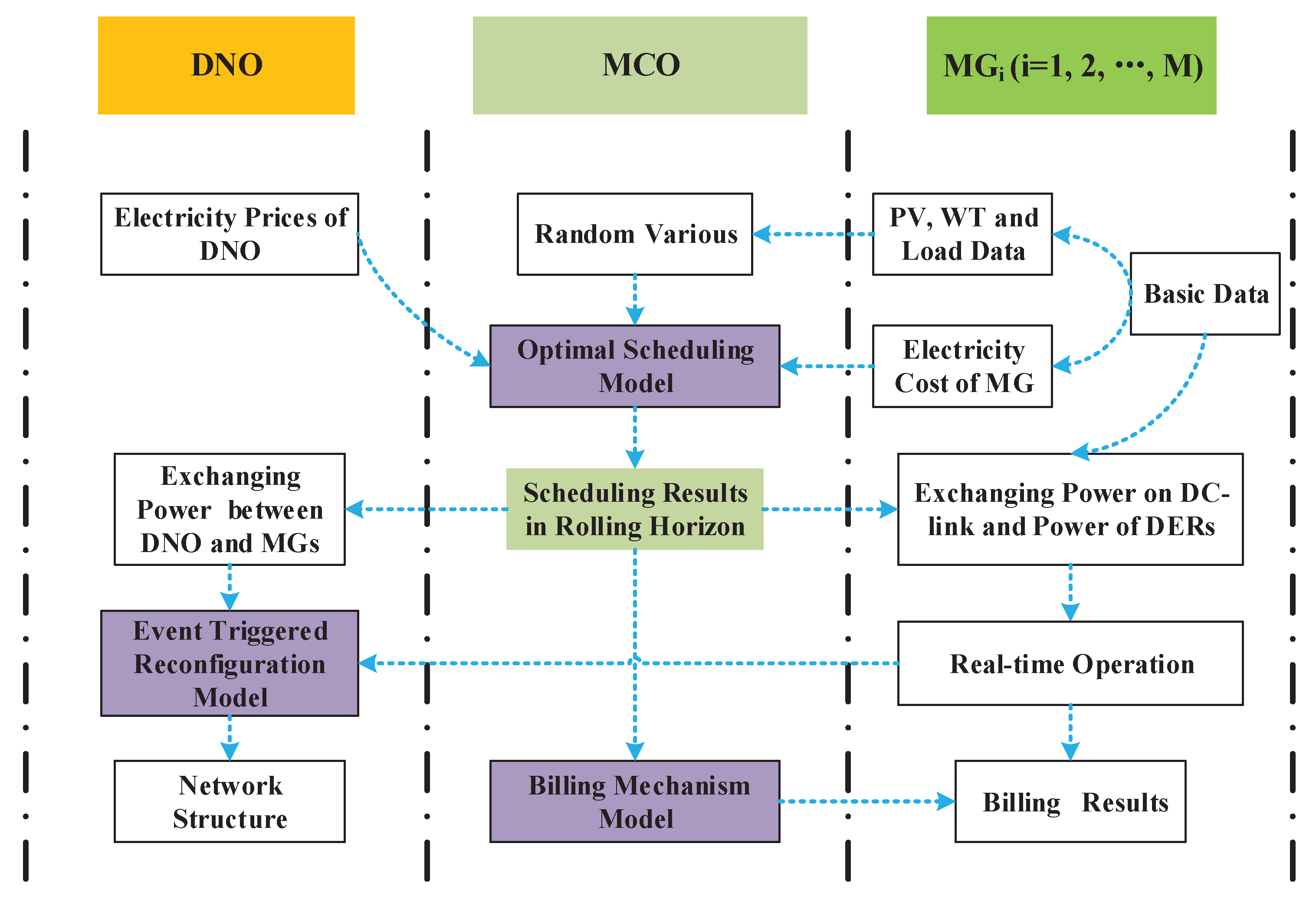
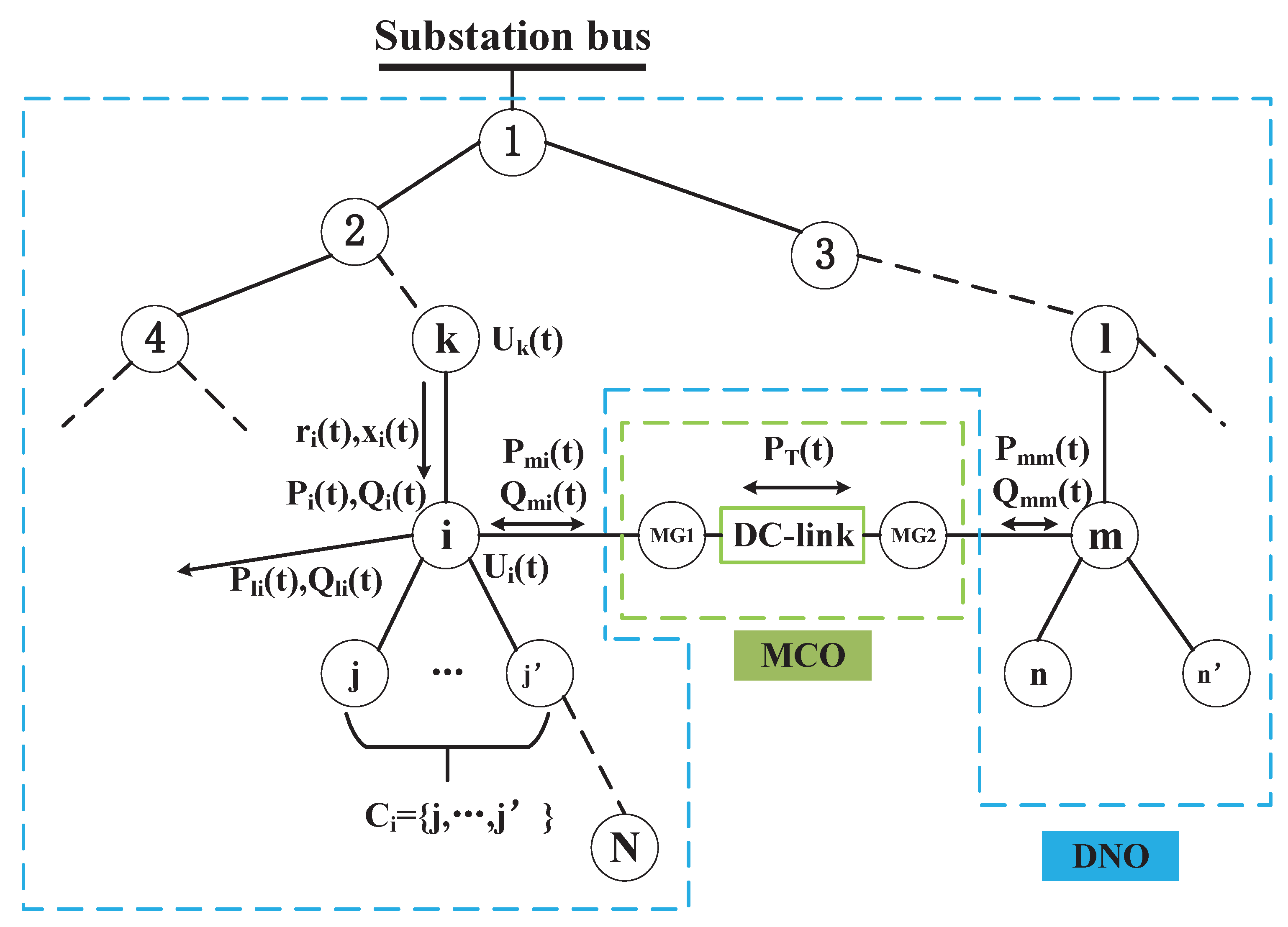
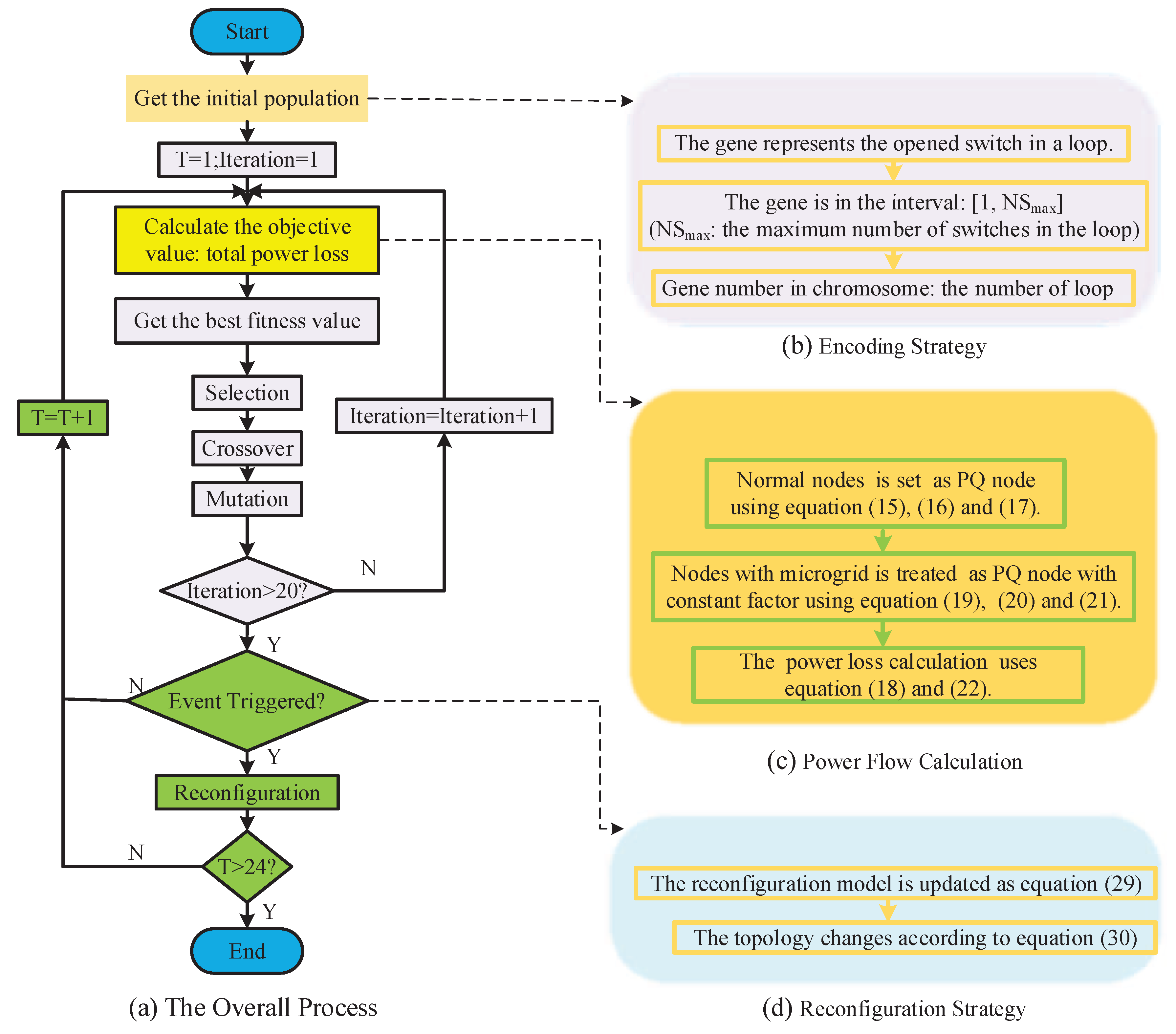

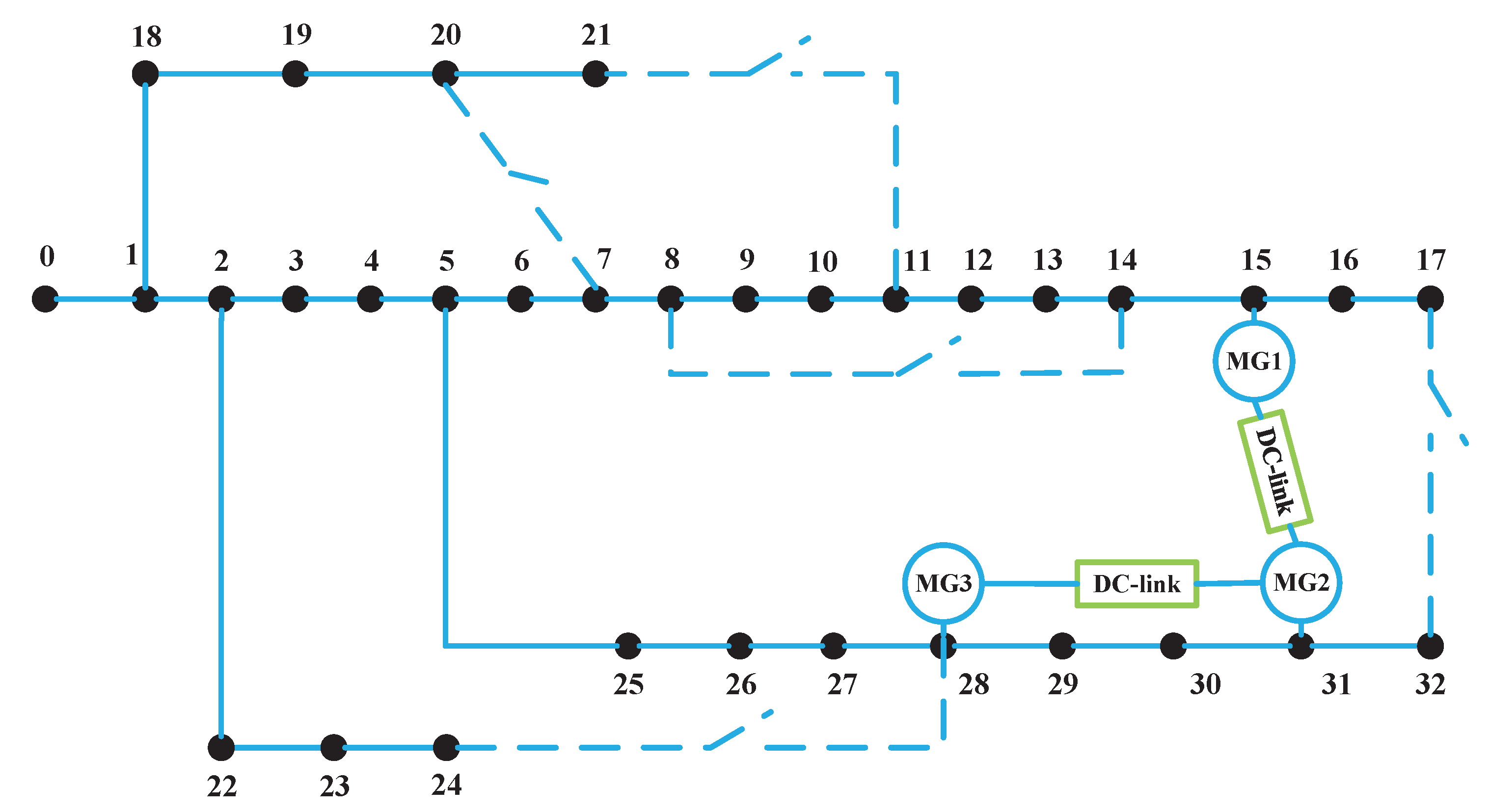
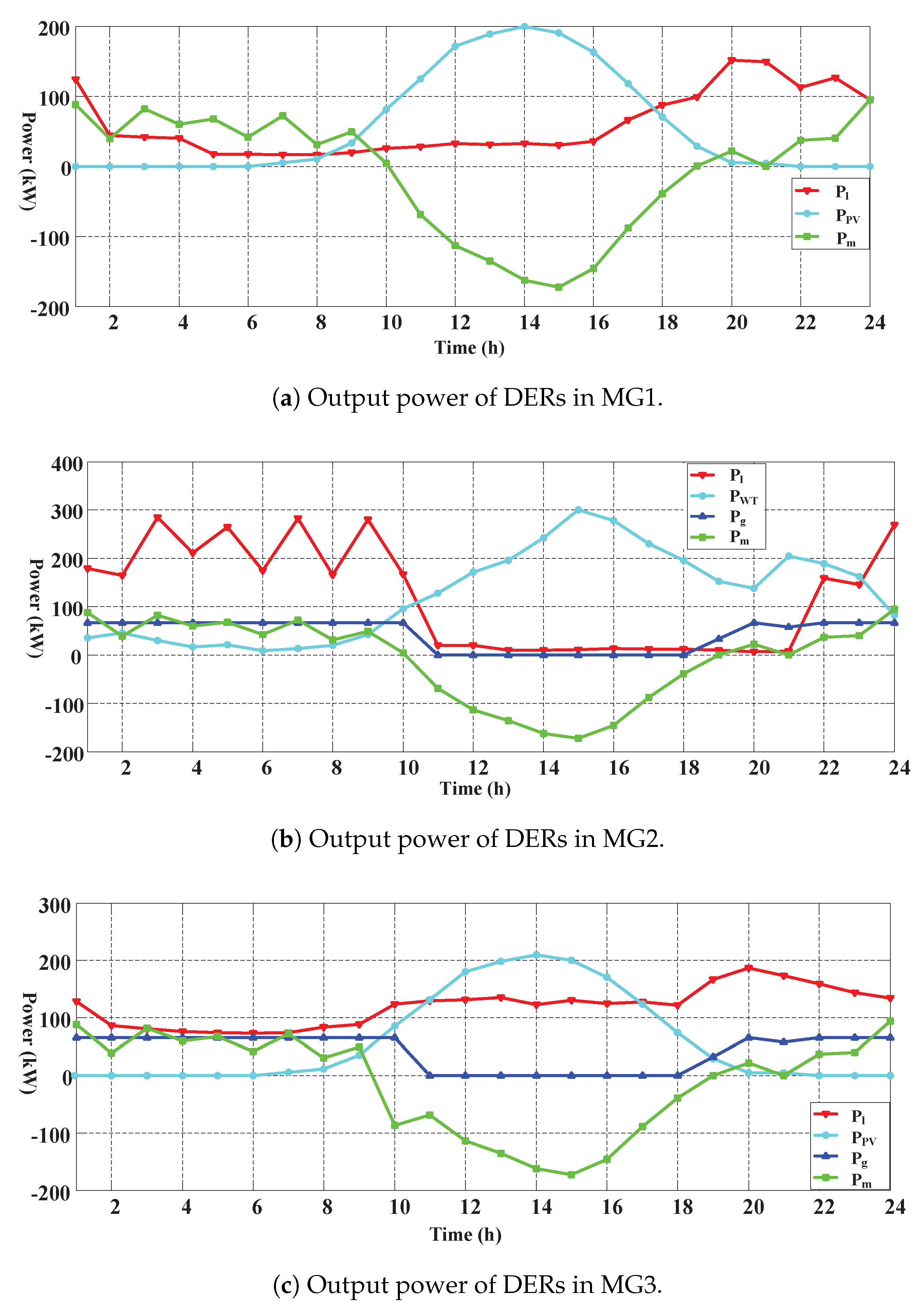
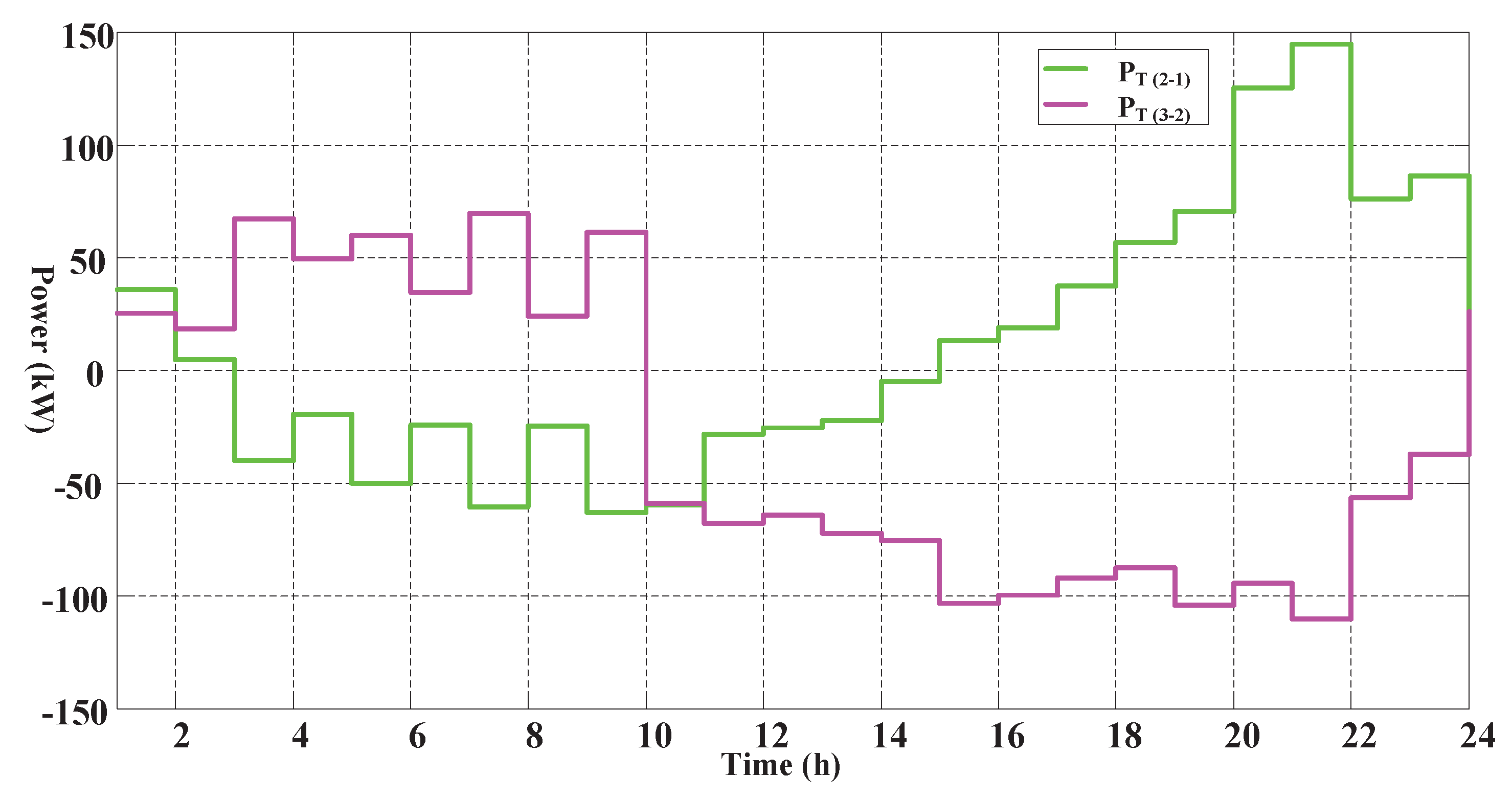
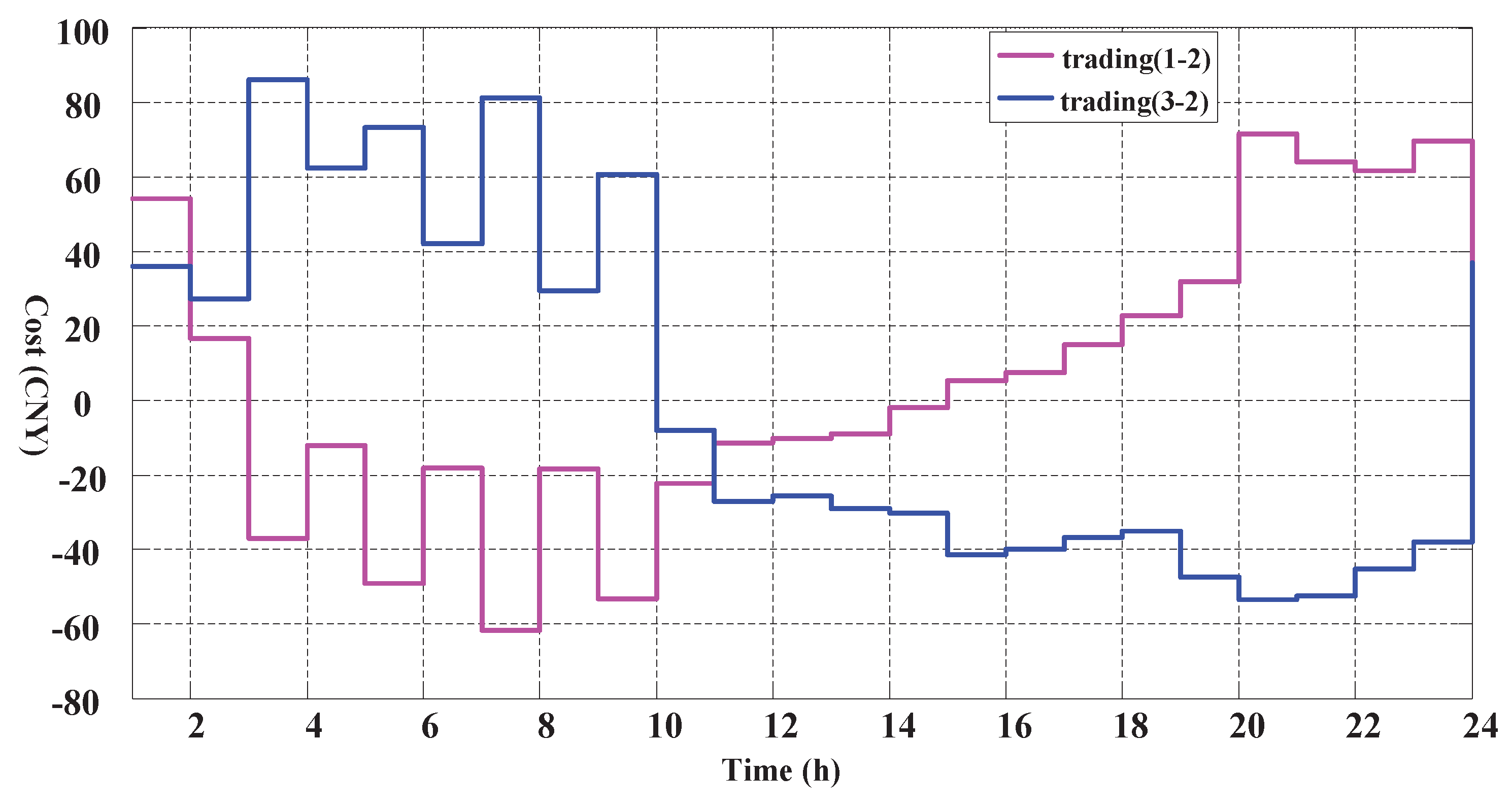
| Microgrid | Connected Node | Load (kW) | Microturbine (kW) | PV (kW) | WT (kW) |
|---|---|---|---|---|---|
| MG1 | 15 | 60 | — | 0–60 | — |
| MG2 | 31 | 210 | 100 | 0–60 | 0–60 |
| MG3 | 28 | 120 | 100 | 0–70 | — |
| Deterministic Programming (CNY/h) | Stochastic Programming (CNY/h) | Reduction Rate (%) |
|---|---|---|
| 220.60 | 194.53 | 11.82 |
| Separated Mode (CNY/h) | Co-Operated Mode (CNY/h) | Reduction Rate (%) |
|---|---|---|
| 207.95 | 194.53 | 6.45 |
| Time Period | Switched Opend |
|---|---|
| 1:00–20:00 | 6–7 11–21 10–11 30–31 26–27 |
| 21:00–24:00 | 6–7 8–9 13–14 30–31 24–28 |
| Reconfiguration Times | Power Loss Cost (CNY) | Power Loss (kWh) | Power Loss Reduction (%) |
|---|---|---|---|
| 0 | 1173.35 | 182.9549 | – |
| 3 | 894.68 | 139.5038 | 23.75 |
| 2 | 876.94 | 121.1111 | 33.80 |
© 2017 by the authors. Licensee MDPI, Basel, Switzerland. This article is an open access article distributed under the terms and conditions of the Creative Commons Attribution (CC BY) license (http://creativecommons.org/licenses/by/4.0/).
Share and Cite
Liu, N.; Guo, B. Multi-Party Optimal Operation for Distribution Networks Containing DC-Linked Microgrids: Integrated Network Reconfigurations and Energy Sharing. Appl. Sci. 2017, 7, 1194. https://doi.org/10.3390/app7111194
Liu N, Guo B. Multi-Party Optimal Operation for Distribution Networks Containing DC-Linked Microgrids: Integrated Network Reconfigurations and Energy Sharing. Applied Sciences. 2017; 7(11):1194. https://doi.org/10.3390/app7111194
Chicago/Turabian StyleLiu, Nian, and Bin Guo. 2017. "Multi-Party Optimal Operation for Distribution Networks Containing DC-Linked Microgrids: Integrated Network Reconfigurations and Energy Sharing" Applied Sciences 7, no. 11: 1194. https://doi.org/10.3390/app7111194




